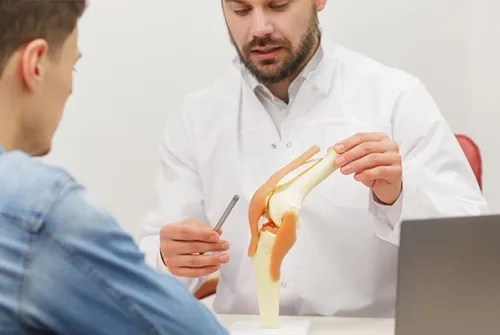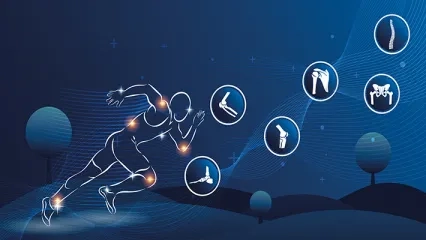Alo Yeditepe
Alo Yeditepe
Joint Pain and Causes of Joint Pain
The Most Common Cause of Joint Pain: Cartilage Wear and Tear
One of the most common causes of joint pain worldwide is cartilage wear and tear, commonly known as osteoarthritis. Joint pain is increasingly observed in the population, attributed to factors such as aging, the rise in obesity, and reduced physical activity. Orthopedics and Traumatology Specialist Prof. Dr. Gökhan Meriç, emphasizing that the disease significantly affects the quality of life due to the movement limitation it creates, stated that effective results can be achieved with stem cell application in the early stages of cartilage wear and tear..
Cartilage damage, a progressive condition characterized by pain, swelling, joint noises, and limited mobility in the knee joint, is a prevalent joint disorder known as osteoarthritis in the community. Dr. Gökhan Meriç emphasized the significance of the issue, stating that according to a 2020 study in the United States, cartilage damage is predicted to be the fourth leading cause of disability in 2030. This condition is one of the most common joint disorders in Turkey and worldwide.
Joint Pains Limit Freedom of Movement
Reminding that knee cartilage damage affects 19% of adults over 45 and 37% of individuals over 60, Yeditepe University Kozyatağı Hospital's Orthopedics and Traumatology specialist explained that this condition significantly impacts the quality of life, especially for those over 60. Our expert emphasized that if early cartilage damage is not treated in young age, it can progress over time, leading to continuous complaints throughout the day due to the restricted movement it causes. In the early stages of cartilage damage, effective results can be achieved through stem cell treatments, according to our specialist.
Inactivity and Obesity Also Increase Osteoarthritis
Our specialist mentioned that the increasing obesity, sedentary lifestyle, and aging population in our country lead more people to seek medical attention due to osteoarthritis every day. "Among these patients, we utilize various intra-articular injections in those whose complaints persist despite pain relievers, weight loss, and exercise," said our specialist.
Effective Results Can Be Achieved with Stem Cell Application
Orthopedics and Traumatology Specialist, Dr. Gökhan Meriç, stated that effective results can be obtained with stem cell application in early-stage cartilage wear patients, despite intra-articular hyaluronic acid and PRP injections in patients with early-stage cartilage wear where complaints persist. He also mentioned that stem cell application can be used in muscle tears in addition to cartilage wear. Providing information about stem cell application for joint pain due to cartilage wear, especially in cases where pain relief or physical therapy is not effective, he explained the purpose of applying stem cells to slow down the tissue damage process, reduce pain, and regain movement: "Stem cells are cells that have the ability to transform into other cells in the body. Fat tissue, bone marrow, and umbilical cord are sources of stem cells in our body. Stem cells are most commonly obtained from bone marrow and fat tissue. The cellular structure of bone marrow and umbilical fat differs in characteristics. Fat tissue contains many more stem cells than bone marrow. Stem cells have many cellular products that reduce inflammation responsible for pain in their structure. Stem cells contribute to reducing pain, reducing swelling, reducing cartilage loss, and accelerating the healing of muscle damage."
How Is the Stem Cell Application Procedure Performed?
Our specialist emphasized the importance of the preparation stages in the stem cell application process and provided the following information on how the stem cell application procedure is carried out:
"In our body, the pelvic bone and abdominal fat are sources where a large number of stem cells can be obtained, and samples are taken from these tissues without putting patients to sleep completely, using mild sedation and local anesthesia. The collected samples go through a separation process to reveal the stem cells within the tissue. The prepared stem cells are applied to damaged areas through injection. The material obtained through these methods is not pure stem cells; it also includes blood products and fluids called plasma. Pure stem cells can only be obtained in a laboratory environment. For pure stem cells, the samples taken from the patient are obtained after a cellular multiplication process that lasts 1-2 weeks; this is a more technical process."
"Surgical Success Is Sought to Be Enhanced with Stem Cell Application"
“Our specialist mentioned, "It is not possible for stem cell application to completely restore the damaged cartilage to its original state. However, studies on cartilage healing have shown an increase in patients' cartilage volume in MR images taken after stem cell application compared to before the application," stating that "In cases where there is sufficient damage to the cartilage, meniscus, or muscle to require surgical intervention, stem cell application alone does not replace the need for intervention; it is not an alternative to stem cell surgery. However, in combination with the intervention, stem cell applications aim to enhance the success of the treatment."
This content was prepared by Yeditepe University Hospitals Medical Editorial Board.
”
See Also
- Robotic Hip Replacement Surgery
- Knuckle Cracking Can Be Dangerous When It Becomes a Habit!
- What is Hallux Rigidus (Stiff Big Toe/Toe Arthritis)? Symptoms and Treatment
- What is Hallux Valgus (Bunion)? How is it Treated?
- Meniscus and Cartilage Transplantation Can Be Done at the Same Time
- Ergonomics in Automobiles Prevents Accidents
- Walking and Returning to Social Life After Knee Replacement Surgery
- Robotic Knee Prosthesis Surgery
- Patients Who Undergo Joint Replacement Surgery Can Stand Up and Walk the Next Day
- Big Toes Can Be A Big Problem!
- What is Synovitis in Joints?
- Hip Impingement Syndrome
- What is the Future of Treating Cartilage Problems?
- Not Only Athletes Suffer from Meniscus Tears!
- Is Cartilage Damage More Common in Those Who Run for Long Periods?
- Beware If Your Shoulder Or Neck Pain Lasts Longer Than Two Days After Swimming!
- Mistakes While Swimming Can Cause Shoulder Pain
- Myths About Fractures
- Vitamin D Deficiency May Be The Cause Of Your Joint Pain
- Have Your Baby Take Their First Steps in Good Health
- Heavy School Bags Can Cause Pain in the Lower Back, Shoulders, and Hands!
- Sports Injuries
- Cartilage Transplantation from Donor Has Been Started to Perform in Turkey
- Working From Home Increases Waist and Neck Problems
- First Cartilage Transplant from a Donor
- Pay Attention to the Pain That Occurs in the Front Part of Your Knees While Playing Sports!
- Young Patient Who Could Not Walk Due to Cartilage Damage Recovered With Cartilage Transplantation
- Knee Arthritis
- Knee Pain
- Crunching in the Kneecap May Be a Sign of Calcification
- Injured Athletes Can Return To Sports With Cartilage Transplant
Alo Yeditepe


